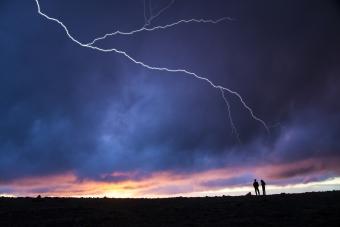
When thunder roars, go indoors. This isn't a silly catchphrase that meteorologists throw out for fun. Lightning safety is important. It saves lives. While you may think that a strike isn't likely to hit you or your family members, why would you ever take that chance? As a veteran meteorologist, I have seen the power and destruction that can come from a solitary thunderstorm. There's a reason we put out warnings.
The best way to make sure that you and your family stay safe is to educate yourself on these natural threats and to be proactive when they enter your region. This lightning safety guide highlights the instances when a strike is most likely to occur and breaks down how parents can keep their family safe.
Lightning Safety Fast Facts
Most of us know to stay away from the swimming pool when lightning begins to light up the sky, but do you know anything else about this meteorological phenomenon? Check out these fast facts on lightning. Some of them may shock you.
-
Approximately one third of lightning strike injuries occur indoors.
- You can get struck by lightning when there's a blue sky above you. Many people don't know that lightning can strike objects up to 12 miles away. However, bolts from the blue can surpass 25 miles.
- The top sports tied to lightning deaths are soccer (34%), followed by golf (29%), running (23%), baseball (9%), football (3%), and disc golf (3%).
- Rubber-soled shoes will NOT protect you from a lightning strike.
- Lightning can occur in a snowstorm.
- You are more likely to get struck by lightning on land than on the water, but lightning strikes over water are much more intense.
- The National Weather Service will NOT issue lightning warnings, and the presence of lightning does not play any role in the issuance of a thunderstorm warning.
Why is this last fact so important? In a world where we depend on our phones to give us pertinent safety information, you will not get any automatic alerts on lightning. That means checking the forecast before outdoor activities is imperative.
Want to get lightning alerts on your phone? Install the My Lightning Tracker and Alerts app on your device.
Lightning Safety Distance Determination
How close is the thunderstorm? The answer to this question can be easily determined by simply counting the time that passes between the flash of lightning and the sound of the next thunderclap.
Once you have determined the number of seconds, divide that figure by five. This will give you the approximate distance in miles that the storm is from your location.
| Number of Seconds | Distance Between You and the Storm |
| 5 | 1 mile |
| 15 | 3 miles |
| 30 | 6 miles |
| 45 | 9 miles |
| 60 | 12 miles |
As you can see, you need more than a minute's worth of time in between thunderclaps in order to be safe from being struck by lightning. Not only that, but if the storm is moving in your direction, this distance could be rapidly decreasing. This is why it's always best to drop what you are doing and head indoors immediately. You should also stay in shelter for at least 30 minutes following the last clap of thunder.
Don't forget about your pets! When thunder roars, bring them indoors as well. The metal on their collars put them more at risk of getting struck.
Outdoor Lightning Safety Tips - What to Do When Lightning Strikes
Meteorologists always tell us that "when thunder roars, go indoors." There's a reason for this - while lightning only kills an average of 28 people per year, it harms hundreds of others, and those 30 microseconds can bring long-lasting health issues. The problem is that when thunder roars, you might not always have access to a place to go indoors. Here's what to do when that happens.

Act Like a Rolly Polly
The easiest way to stay safe during a lightning storm when no shelter is available is to crouch down, tuck your head down into your knees, wrap your arms tightly around the sides of your head, and get on your toes. The intent is to get as close to the ground as possible while also touching as little of the surface as you can. NEVER lie on the ground. This makes you a much bigger target.
Do NOT Stay in a Group
Again, the intent is to make yourself as small as possible. If everyone crouches down together, you are creating a large target. Instead, separate from one another.
Stay Away From Tall Objects
Lightning is almost always going to strike the tallest object in the area. That means trees, power poles, and tall buildings are most at risk for strikes. This also means that you need to stay away from these structures. Many people don't realize that the current from the lightning strike can jump from one object to another. Thus, if you are standing under the tree, you can still get struck.
Get Away From Water
Even though lightning is more likely to strike over land, 35 percent of lightning deaths are tied to water-related activities. This means that getting out of or off of the water is one of the main keys to survival. When thunder roars, head back to shore immediately. If there isn't enough time, then seek shelter in the boat's cabin. If there is no cabin available, separate from other boat mates and crouch down as directed above.
Don't Seek Shelter in Open Structures
Just because you're not getting rained on doesn't mean that you're safe from a lightning strike. Baseball dugouts, screened porches, tents, shallow caves, rocky overhangs, and gazebos are not safe when lightning is around.
If fact, by staying in these areas, you're putting yourself more at risk. Not only are these taller structures, but most of them have concrete as a part of their construction. This material can conduct electricity.
Drop Metal Objects and Wet Items
One of the main reasons fishing is the number one cause of water-related lightning deaths is the pole. Remember that your safety is always the most important thing. Drop your fishing pole, golf club, umbrella, or any other metal object. Both metal and water can conduct electricity, so holding wet rope or fabric is also a bad idea. Leave the items and come back for them later.
Indoor Lightning Safety Tips
Yes, you can get struck by lightning indoors, so you need to stay proactive when thunderstorms move overhead. Here are the top ways that parents can keep their kids safe.

Stay Away From Windows and Doors
The say curiosity killed the cat. When it comes to lightning, this can be true. While it may seem enticing to look at nature's light show, it's important to remember that most door and window frames have metal components built into them. By touching this conductive material, you give the lightning an easier path to you.
Do Not Shower or Do the Dishes
No, this is not an old wive's tale. You can get struck by lightning while showering. Lightning can travel through metal pipes, which makes any activity that involves the tub or sink dangerous during a thunderstorm. Therefore, wait to shower, bathe, shave, wash dishes, or even wash your hands.
While you may be thinking that it only takes 20 seconds to wash your hands, remember that it takes 30 microseconds for a lightning strike to occur. For those who don't know, there are a million microseconds in a second. Be safe and use hand sanitizer if a thunderstorm is nearby.
Don't Use Electrical Equipment Attached to the Wall
Just like lightning can travel through the plumbing, it can also travel through the electrical wiring in your walls. Therefore, using corded phones, PC computers, televisions, and even smart phones that are charging can put you at risk. If you can unplug the device, you will likely be fine, but stay safe and cease use of electronics that are plugged in until the storm has passed.
Lightning Car Safety
Contrary to popular belief, while most cars are safe in a lightning storm, you can actually get struck while in the vehicle if the conditions are right. These are some simple tips to ensure that you stay safe while on the road.

Get Out of Open Vehicles
Just like with open structures, open vehicles like convertibles, soft top jeeps, motorcycles, and golf carts are not safe places to shelter in a lightning storm. If you are in one of these vehicles when thunder roars, get to an alternate shelter immediately.
Make Sure to Close Windows and Doors
If lightning has a path inside your car, you are no longer safe. Close windows and doors the moment you hear thunder.
Avoid Touching Conductive Materials
Many people think it's the rubber tires that keep you safe in a car during a thunderstorm. In reality, it's the metal frame. This makes this part of the car extremely dangerous. If you get caught in a lightning storm, have your family keep their hands in their laps and away from the framework of the car, the door handles, and metal buckles.
Unplug Devices
Just like in your home, you want to avoid using electronics that are plugged in. Since many cars have charging ports, it's important for parents to unplug all devices in the vehicle when lightning is in the vicinity.
Lightning Safety Starts With Urgency
The reason meteorologists always say to go indoors when thunder roars is because usually, the storm has not reached you yet. This gives you some lead time to get to shelter safely. Take Mother Nature's warning to heart and be proactive when lightning is approaching. Also, go over lightning safety with your kids every year, especially in the summer months when the threat is higher.







